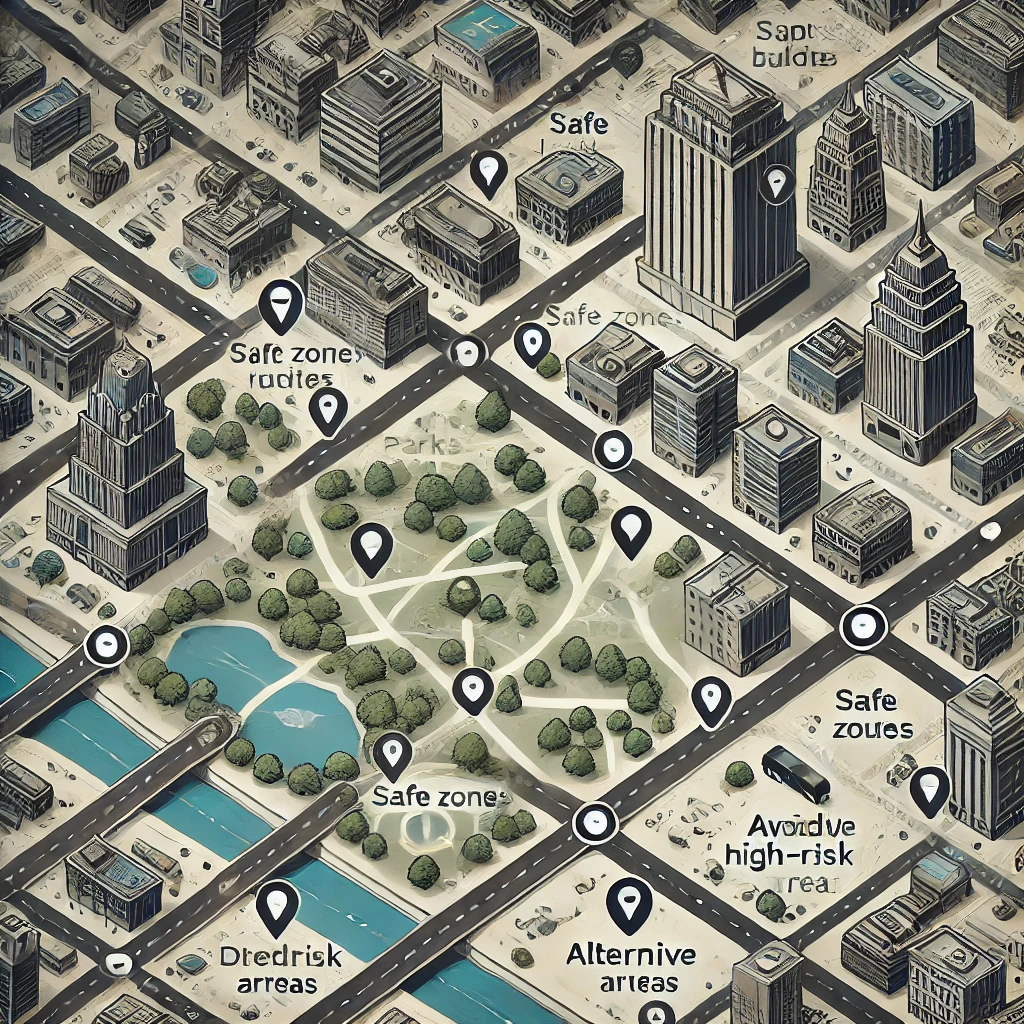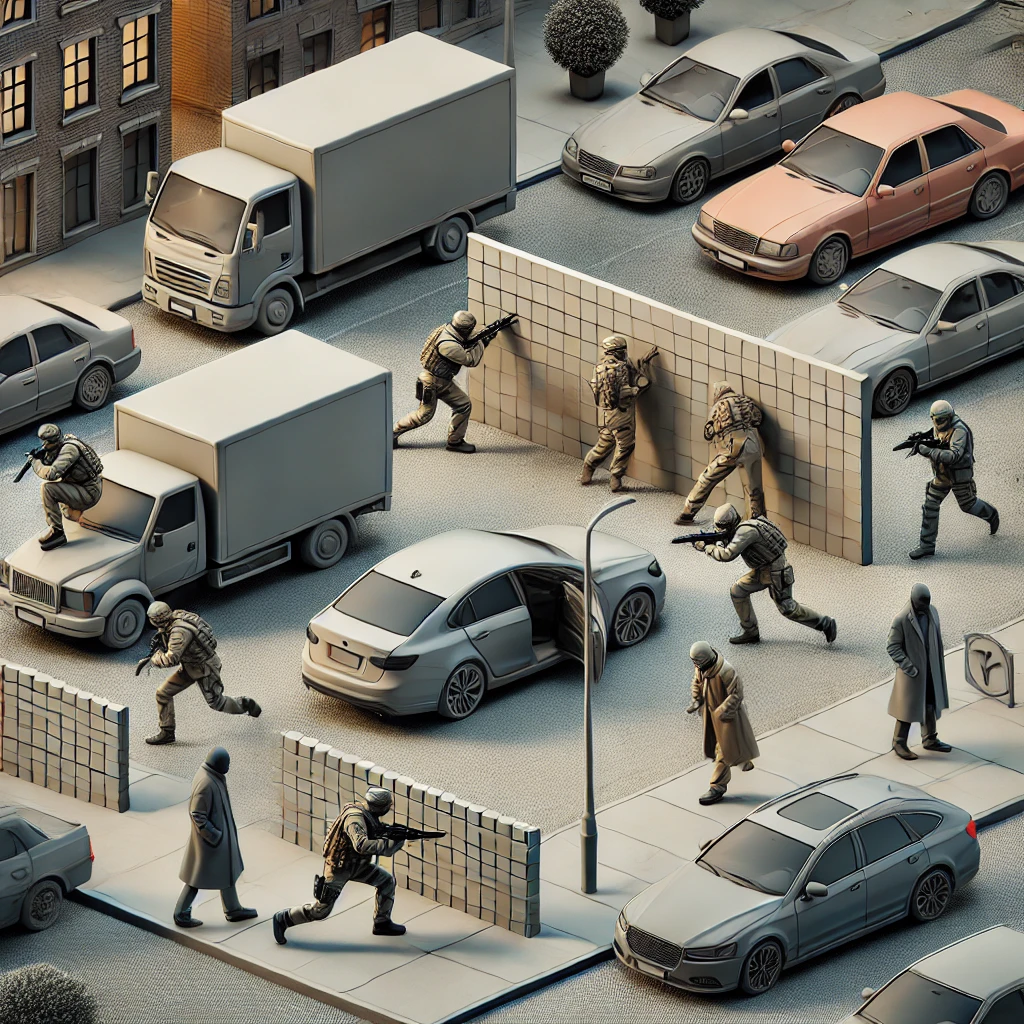When disaster strikes in an urban environment, navigating the dense, crowded streets of a city becomes a unique challenge. In times of crisis, familiar routes can turn into unpredictable hazards, and typical methods of getting around—like relying on GPS or public transportation—may no longer be available. Knowing how to navigate safely without these tools is crucial for urban survival in an emergency. This guide will cover essential urban tactical navigation skills, from identifying reliable landmarks to avoiding dangerous areas, so you can move strategically and confidently, even when the city seems chaotic.

1. Understanding the Urban Landscape
City urban tactical navigation during a crisis differs from navigating rural or wilderness areas. Here, you’re faced with a dense population, tall buildings, and infrastructure that can both help and hinder your movement. Crowded streets, gridlock, and limited escape routes mean it’s essential to stay informed and flexible.
- Challenges in Urban Navigation: During a crisis, streets may be blocked by abandoned vehicles or desperate crowds. Buildings can serve as shelter, but they can also trap you if routes become clogged or unsafe. Moreover, in a large city, natural landmarks may be limited, making it harder to orient yourself without traditional navigation tools.
- Advantages of the City Landscape: While cities present challenges, they also offer unique resources. Abandoned buildings may hold supplies or provide temporary shelter. Rooftops and balconies can serve as observation points to assess the area before moving. Knowing your city’s layout can help you locate these resources more quickly.
2. How to Navigate Without GPS: Essential Tips
Relying on GPS and other digital tools is second nature for most of us, but in a crisis, these may be unavailable or unreliable. Familiarizing yourself with grid-down navigation techniques is essential for safe urban movement.
- Identify Reliable Landmarks: Buildings, bridges, and major intersections are your best navigational aids in an urban environment. High-rise buildings or prominent structures, such as water towers or communication towers, can serve as orientation points. Note which landmarks are visible from different parts of your city—this will help you determine your direction and avoid getting lost.
- Know Your Surroundings: Memorize the layout of the area where you live and work, including major streets, parks, and open spaces. Regularly explore your neighborhood on foot, paying attention to side streets, alleys, and potential shortcuts. This familiarity will make it easier to find alternative routes if primary roads become dangerous or congested.
- Map Your Paths: Practice navigating without GPS by using physical maps or mental mapping techniques. Start by memorizing key routes and the layout of nearby streets. Consider carrying a paper map with you—this low-tech backup can be invaluable if all else fails.
3. Avoiding High-Risk Areas in an Urban Survival Scenario
In an urban emergency, certain areas can quickly become hazardous. By knowing where these danger zones are, you can plan safer routes and avoid crowds.
- Identify Common Gathering Points: During a crisis, people often flock to places like grocery stores, hospitals, or public transportation hubs. While these may be necessary stops, they’re also areas where crowds can quickly escalate into chaos. Identify alternative sources for supplies when possible, and avoid high-traffic areas if you don’t need to be there.
- Understand Crowd Behavior: Crowds can be unpredictable and potentially dangerous. Observing how people move, react, and gather in certain spaces can give you insight into where tensions might be building. Avoid crowds as much as possible, and if you must move through one, stay calm, blend in, and avoid drawing attention to yourself or your supplies.
- Map Alternative Routes: When navigating during a crisis, main roads may be congested or blocked. Identify side streets, alleys, and open spaces that offer alternative ways to reach your destination. These routes can also help you avoid areas where panic might be escalating.
4. Blending in With Your Environment: Grey Man Theory
One of the most important skills in urban tactical navigation during a crisis is the ability to blend in, a tactic often referred to as “Grey Man Theory.” When you move unnoticed, you’re less likely to draw attention from those who may see you as a threat or a target.
- Dress Practically and Neutrally: Avoid flashy or attention-grabbing clothing, as it can make you stand out. Wear neutral colors and comfortable clothes that allow you to move easily. Avoid large backpacks or bulging bags that might signal you’re carrying valuable supplies. If you’re carrying a survival pack, consider disguising it in a standard-looking bag.
- Move Confidently but Calmly: Panic is contagious, and moving too quickly or anxiously can make you a target. Walk calmly and with purpose, as if you’re familiar with the area and know exactly where you’re going. Avoid eye contact with others, but remain aware of their actions and movements.
- Act Like You Belong: People are less likely to question or approach you if you seem like a regular part of the environment. If you’re forced to move through a crowd, adopt the same behavior as those around you. Keep your head down, avoid conversation, and avoid any actions that might draw attention.
5. Tactical Movement Techniques for Urban Navigation
Moving effectively and safely in an urban environment requires more than simply walking from point A to point B. Tactical movement involves using cover, timing, and situational awareness to minimize risk.
- Use Cover and Concealment: Buildings, walls, and even parked cars can provide cover as you move. Move from one point of cover to the next, pausing briefly to assess your surroundings before continuing. Avoid moving through open areas if possible, as these expose you to more risk.
- Time Your Movement: If possible, travel during times when fewer people are on the streets. Early morning or late evening may be safer times to move, depending on the situation. Avoid peak hours, when crowds or other dangers are likely to be higher.
- Stay Aware of Your Surroundings: Constantly observe your surroundings for potential threats, obstacles, or opportunities for concealment. Situational awareness is key to avoiding unexpected encounters or traps. Listen for sounds, look for unusual activity, and stay vigilant as you navigate.

6. Establishing Bug-Out Routes and Safe Zones
If an urban area becomes unsafe, having pre-planned escape routes, or “bug-out routes,” can make the difference between escaping danger and getting trapped.
- Plan Multiple Bug-Out Routes: Map out several potential routes out of the city, taking into consideration different types of crises. For example, a flood may block one route, while civil unrest could make another unsafe. Identify at least three options, and practice each route if possible to identify potential challenges or roadblocks.
- Identify Temporary Safe Zones: Safe zones are places you can stop to rest, gather supplies, or regroup. These might include parks, parking garages, or areas with natural cover. In a crisis, safe zones provide opportunities to recharge or strategize before continuing your journey.
- Scout Potential Obstacles: In an urban setting, obstacles can appear suddenly, such as fallen debris, barricades, or damaged infrastructure. Familiarize yourself with alternate routes around potential obstacles, and have contingency plans if you find your path unexpectedly blocked.
7. Building Situational Awareness
Situational awareness is your ability to read the environment around you and react appropriately to changes. In urban survival, it’s one of your most valuable tools.
- Observe Patterns in the Environment: Pay attention to normal patterns in your area, such as the times when certain places are busy or quiet. These patterns will shift during a crisis, and recognizing abnormal behaviors can alert you to potential threats.
- Listen for Unusual Sounds: Sounds can alert you to nearby crowds, vehicles, or signs of distress. Avoid using headphones or distractions, as staying attuned to noises can provide early warning of approaching danger.
- Assess Your Surroundings Continuously: Regularly scan your surroundings and identify potential escape routes, threats, and resources. Develop the habit of checking over your shoulder, watching reflections, and observing people’s movements. This situational awareness allows you to act proactively rather than reactively.
Conclusion: Mastering Urban Tactical Navigation for Survival
Navigating a city during a crisis requires patience, preparation, and a calm, strategic mindset. By understanding the urban landscape, avoiding high-risk areas, and using tactical movement techniques, you can navigate the city more safely. Remember, your primary goal is to reach safety while staying as unnoticed and unbothered as possible. With these skills, you’re better equipped to face the unpredictability of an urban disaster and move through the city with confidence.
